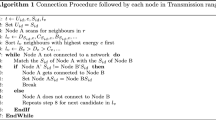Abstract
The paper is devoted the description of specific features of Ad-Hoc technology implementation. The possibility of significant increase of the radio communications stability without introducing structural redundancy into the system is shown. For this, it is proposed to use mobile stations deployed on the terrain in non-stationary circumstances and operating in the retransmission mode. The use of repeaters is considered as a tool to improve the structural reliability of Ad-Hoc network, as well as a tool for reducing intra-system interference. The feasibility assessment of using automatic transmitter’s power adjustment for radio stations within a decentralized mobile Ad-Hoc network is performed. The measure of intra-system interference level reduction is estimated at the receiving point based on the assumption of subscribers’ random location on the terrain. It is concluded that the combination of automatic transmitter power adjustment for subscriber stations using an auxiliary repeater-station can improve the electromagnetic compatibility conditions of radio equipment in communication systems with mobile objects. This measure is an effective way to economical use of the radio spectrum allocated to communication systems with moving objects. It is important to emphasize that the operation conditions of many mobile radio communications systems do not always allow us to achieve improvements in the characteristics of stability and communication quality by generally accepted organizational and technical means. Therefore, the search for effective ways to improve radio systems operating in adverse conditions remains as an interesting and important task. In this article, the attempt has been made to show new possibilities that retransmission of signals gives precisely in such mobile systems taking into account their features.
Access this chapter
Tax calculation will be finalised at checkout
Purchases are for personal use only
Similar content being viewed by others
References
Features and uses of an ad hoc wireless network. https://www.lifewire.com/what-is-an-ad-hoc-wireless-network-2377409
Bondarenko O, Ageyev D, Mohammed O (2019) Optimization model for 5G network planning. In: 2019 IEEE 15th international conference on the experience of designing and application of CAD systems (CADSM). IEEE, pp 1–4. https://doi.org/10.1109/CADSM.2019.8779298
Kryvinska N (2010) Converged network service architecture: a platform for integrated services delivery and interworking. Electronic business series, vol 2. International Academic Publishers, Peter Lang Publishing Group
Ilchenko ME, Moshinskaya AV, Urywsky LA (2011) Levels separation and merging in the OSI reference model for information–telecommunication systems. Cybern Syst Anal 47:598. https://doi.org/10.1007/s10559-011-9340-4
Bunin SG (2013) UWB and ad hoc networks are future of telecommunications. Wireless Ukraine 13–14(1–2):38–42
Hepko IA, Oleynik VF (ed), Gull YD, Bondarenko AV (2009) Modern wireless networks: state and prospects of development. ECMO, Kyiv
Urywsky L, Shmigel B (2014) Analyze the productivity of mobile communication system with nano- and pico-cellular. Sci Prod Collect Sci Notes Ukrainian Res Inst Commun 4:5–10
Ilchenko M, Urywsky L (2010) Aspects of system analysis in the applied information theory for telecommunications. Cybern Syst Anal 46(5):737–743. https://doi.org/10.1007/s10559-010-9255-5
Ore O (1962) Theory of graphs. American Mathematical Society
Burshtynska KhV (2002) Kolokatsiia z umovamy u tsyfrovomu modeliuvanni reliefu. Heodeziia, Kartohrafiia I Aerofotoznimannia. 62:103–110
Author information
Authors and Affiliations
Corresponding author
Editor information
Editors and Affiliations
Rights and permissions
Copyright information
© 2021 The Author(s), under exclusive license to Springer Nature Switzerland AG
About this chapter
Cite this chapter
Uryvsky, L., Moshynska, A., Osypchuk, S. (2021). Improving the Structural Reliability of Mobile Radio Networks Based on the Ad-Hoc Algorithms. In: Ageyev, D., Radivilova, T., Kryvinska, N. (eds) Data-Centric Business and Applications. Lecture Notes on Data Engineering and Communications Technologies, vol 69. Springer, Cham. https://doi.org/10.1007/978-3-030-71892-3_2
Download citation
DOI: https://doi.org/10.1007/978-3-030-71892-3_2
Published:
Publisher Name: Springer, Cham
Print ISBN: 978-3-030-71891-6
Online ISBN: 978-3-030-71892-3
eBook Packages: Intelligent Technologies and RoboticsIntelligent Technologies and Robotics (R0)




